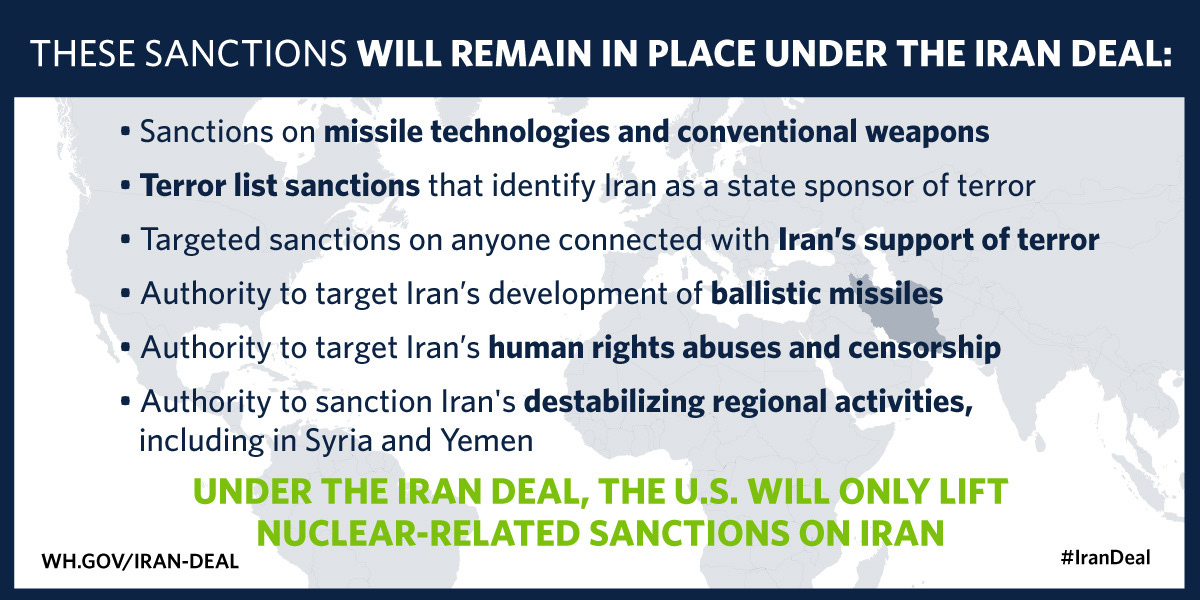Author’s Note: For the rest of this month, I’ll be taking a break from this project to focus more time on work and family. See you in October!
In 2015, something happened that no one thought was possible — all five permanent members of the UN Security Council agreed on something.
The Joint Comprehensive Plan of Action (JCPOA), colloquially referred to as the Iran (Nuclear) Deal, went into effect in January 2016. China, France, Russia, the United Kingdom, the United States, and Germany1 entered into an agreement with Iran to prevent Iran from building nuclear weapons.
As you may have heard, and as these things tend to go, the Deal fell apart within ten years, and we’re just now starting to come around to a new, partial solution. What happened? What are they going to do about it? How can we make better nonproliferation treaties in the future?

Goals
The intention of P5+1 was to send Iran’s nuclear program back in time; they wanted to extend the state’s “breakout time,” or the time it takes to produce enough highly enriched uranium (HEU) to build a nuclear weapon. The goal was to give the international community at least one year’s warning if Tehran violated the deal and began producing HEU.
If Iran developed nuclear weapons, the logic went, the region would face a crisis which could easily spin out of control. Without assurances, Israel would likely freak the fuck out order a (second) preemptive strike against Iran’s nuclear facilities, as it already has in different contexts (Syria and Iraq). Aside from likely disrupting the transport of oil in the region,2 such an attack might trigger military reprisals with catastrophic consequences.
For Iran, the JCPOA represented an opportunity for sanction relief. In the early 2010s, Iran’s exports declined by an average of one third, representing $104 billion USD in lost revenue. As part of the deal, the P5+1 agreed to lift any nuclear-related sanctions — although other U.S. sanctions remained in effect, including restrictions on financial transactions, which deter international trade.3

Implementation
To qualify for sanction relief (and maintain a semblance of regional stability, apparently), Iran agreed to dismantle most of its nuclear program, including some of its civilian program. Its facilities were also required to be open to international inspections.
From what we can tell, in 2016, Iran was implementing these changes. Between January and October 2016, Iran purportedly shipped 25,000 pounds of HEU out of the country, dismantled two-thirds of its centrifuges (for enriching more uranium), and provided the IAEA access to its nuclear facilities. The IAEA certified that Iran had met its preliminary pledges, and the E.U., U.S., and U.N. responded by suspending their sanctions.
The Problem
In 2018, Donald Trump announced U.S. withdrawal from the Iran Deal, following a joint statement with Israel that alleged Iran’s failure to disclose a past nuclear weapons program to the IAEA violated the JCPOA.
In response to U.S. withdrawal, Iran began increasingly limiting the IAEA’s access to its nuclear facilities. Following the U.S. assassination of Maj. Gen. Qasem Soleimani in late 2020 and its backing of further assassinations with Israeli assistance, Iran recommitted to developing its nuclear program. From 2019, they began exceeding limits placed on low-enriched uranium, and since 2020 they began boosting rates of HEU production. its stockpile is now more than 20 times the limit agreed upon in the JCPOA.
Since U.S. withdrawal in 2018, Crown Prince Mohammed bin Salman has also announced Saudi Arabia’s interest in developing nuclear weapons “as soon as possible” if Iran does so first. While their stated intentions are defensive, creating yet another nuclear standoff between political rivals would quickly heighten risks posed to the whole world.
Earlier this year, UN inspectors reported that Iran had enriched uranium nearly to weapons-grade levels, which is a big reason this international drama has made more headlines recently.
The Future
Months after the UN discover, in March of 2023, Iran committed to increase its cooperation with the IAEA. It appears that Iran will continue to hedge at the nuclear threshold, having the capacity and the know-how to build nuclear weapons, but not quite putting the two together. This positioning is its own kind of deterrence, and, as you can tell from the stipulations in the JCPOA, potentially a powerful bargaining chip.
This June, Washington made some progress on an informal deal with Tehran, although it remains to be seen if this will move forward into practice. This “purported agreement” would include commitments from Iran to avoid approaching 90% HEU, refrain from expanding stockpiles or installing more centrifuges, continue cooperating with the IAEA, and release three U.S. citizens currently detained in Iran on espionage charges. In return, the United States would release frozen Iranian funds, including payments owed to Iran from South Korea and Iraq nearing $10 billion, and release four Iranian citizens.
Still, it seems that most European experts agree returning to something more like the original JCPOA is the only sustainable way to ensure nonproliferation in Iran. The EU is heavily invested in negotiations with Iran, including reestablishing the JCPOA and limiting or eliminating weapons sales to Russia.
In developing future international deals, all I can recommend is that certain parties should probably stop assassinating high-ranking officials of other parties involved in the deal. My estimation is that this would greatly improve international stability and the average outlook for nuclear nonproliferation deals.
The P5+1: five permanent members of the UN Security Council, plus Germany.
Something the United States absolutely cannot allow.
As you might expect, sanction relief without lifting restrictions on financial transactions mostly benefited the upper classes, and has not actually been reflected in meaningful improvements to the average household budget.




